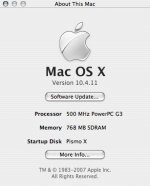coius
Well-known member
After about 15 minutes of prep/soldering, I bumped up my Pismo to 500Mhz from 400Mhz.
so the setup is:
PowerBook G3 500Mhz/1MB L2
100Mhz FSB
768MB RAM (256MB lower slot, 512MB upper)
80GB 7200RPM HDD, DVD/CD-RW Slot-load optical, brand new 6500Mah battery, original G3 Pismo powerbook power adapter (black brick). 14" LCD. ATI Rage 128M 8MB AGP 2x Graphics card
Airport, 10/100 Fast Ethernet, 2x FW400 ports, 2x USB 1.1 ports, USB 2.0 PC Card, Belkin 802.11b/g PC Card (in case I need G access). Sound in/out, 56Kbps Modem
It's actually quite a bit quicker than the 400Mhz. Windows are slightly more responsive under OS X, typing keeps up now in web browsers, and it loads pages quicker. Not bad...

so the setup is:
PowerBook G3 500Mhz/1MB L2
100Mhz FSB
768MB RAM (256MB lower slot, 512MB upper)
80GB 7200RPM HDD, DVD/CD-RW Slot-load optical, brand new 6500Mah battery, original G3 Pismo powerbook power adapter (black brick). 14" LCD. ATI Rage 128M 8MB AGP 2x Graphics card
Airport, 10/100 Fast Ethernet, 2x FW400 ports, 2x USB 1.1 ports, USB 2.0 PC Card, Belkin 802.11b/g PC Card (in case I need G access). Sound in/out, 56Kbps Modem
It's actually quite a bit quicker than the 400Mhz. Windows are slightly more responsive under OS X, typing keeps up now in web browsers, and it loads pages quicker. Not bad...




